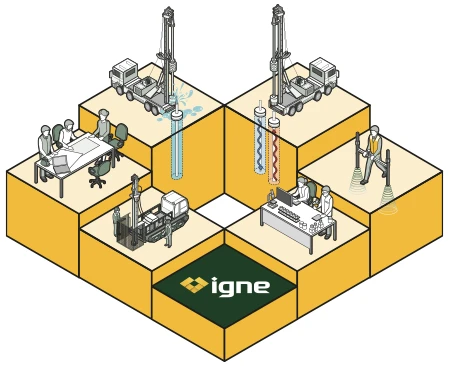

USV Inland Water Surveys: Precision Mapping for Inland Waterways
Unmanned surface vehicle (USV) inland water surveys involve the use of USVs equipped with sonar technology and other sensors to map and monitor the depths, contours, and characteristics of rivers, lakes, reservoirs, and other inland water bodies.
About
What are USV Inland Water Surveys?
These surveys provide crucial data about underwater environments, offering insights into everything from water depth and sedimentation to the detection of underwater obstructions.
The use of USVs allows for accurate, efficient, and safe surveying in areas that may be difficult or unsafe for manned vessels to access.
USVs autonomously or remotely navigate inland waters, collecting high-resolution bathymetric data. This data is then processed to create detailed maps that can be used for various applications, such as flood risk management, infrastructure development, environmental monitoring, and navigation safety.
Useage
Why are USV Inland Water Surveys Useful, and for Whom?
USV inland water surveys are valuable across a range of industries, providing essential information to several key sectors:
Flood Risk Management
Government agencies, local authorities, and flood risk managers rely on USV surveys to assess water flow, sediment build-up, and the capacity of rivers and reservoirs. This data helps predict and manage flood risks, allowing for better planning and implementation of flood prevention measures.
Infrastructure Development
Engineers and construction teams use USV inland water surveys to assess the suitability of sites for bridges, dams, piers, and other water-adjacent structures. The data collected ensures that projects are built on solid foundations and that water levels and conditions are adequately accounted for in the design.
Environmental Monitoring
Conservationists and environmental scientists use USV surveys to monitor ecosystems, track changes in underwater terrain, and assess the health of aquatic habitats. This is particularly important for maintaining biodiversity and preventing erosion or sedimentation that could impact the local environment.
Navigation & Waterway Safety
Inland waterway operators and maritime authorities use USV surveys to map the underwater topography, identifying hazards such as submerged rocks, debris, or shallow areas. This ensures that vessels can navigate safely and efficiently.
Trust
Why Choose Igne for USV Inland Water Surveys?
At Igne, we have extensive experience in conducting bathymetric and geotechnical surveys, using the latest technology to provide accurate, reliable data. Our team of experts combines technical know-how with an in-depth understanding of water-based projects, ensuring that we deliver actionable insights tailored to your specific needs.
Igne’s USV inland water surveys are conducted using advanced equipment, allowing us to gather high-resolution data efficiently and with minimal disruption to the environment.
Whether you need to assess flood risks, plan infrastructure projects, or monitor environmental changes, Igne’s commitment to quality and safety means that you can trust us to deliver the results you need.
We operate across a wide range of sectors, providing bespoke surveying solutions that are designed to minimise risk, improve project outcomes, and ensure compliance with all relevant regulations. When you commission Igne for USV inland water surveys, you’re not only gaining access to state-of-the-art technology but also to a team of experts dedicated to the success of your project.
Risks
The Risks of Not Conducting USV Inland Water Surveys
Neglecting regular roof inspections can lead to several risks that may jeopardise the integrity of a building and increase costs over time.
Flood Risk
Without accurate bathymetric data, flood risk models may be incomplete, leading to insufficient protection measures. This could result in unpredicted flooding, endangering lives, damaging property, and causing environmental harm.
Structural Failures
For infrastructure projects such as bridges or dams, not conducting a thorough waterbed survey increases the risk of building on unstable or unsuitable terrain. This can result in costly delays, repairs, or even structural failure.
Environmental Damage
Ignoring the need for underwater surveys can lead to unnoticed sedimentation, erosion, or damage to aquatic ecosystems. This not only threatens biodiversity but can also result in legal and regulatory challenges.
Navigation Hazards
Failure to map underwater features can leave navigational hazards such as rocks, debris, or shallow areas undetected. This increases the risk of accidents, collisions, or grounding for vessels navigating inland waterways.
Benefits
The Benefits of USV Inland Water Surveys
USV inland water surveys offer numerous benefits that go beyond simply providing data. The use of cutting-edge technology and non-invasive methods makes these surveys a vital part of many projects:
Enhanced Accuracy
USVs are equipped with high-resolution sonar and GPS systems, ensuring that the data collected is precise and reliable. This level of accuracy is critical for projects that require detailed underwater mapping, such as infrastructure development or environmental monitoring.
Safe & Efficient
USVs can access areas that are difficult or unsafe for manned vessels, reducing the risks to personnel. They can operate in shallow, narrow, or hazardous waters with ease, ensuring comprehensive data collection without putting human lives at risk.
Cost-Effective
The speed and efficiency of USV operations reduce the time and labour required for inland water surveys. By identifying potential issues early, USV surveys help prevent costly delays and unforeseen complications later in the project.
Minimal Environmental Impact
USVs operate with minimal disturbance to the aquatic environment, making them ideal for projects in sensitive or protected areas. Their low environmental footprint ensures that wildlife and ecosystems are not disrupted during the survey process.
Real-Time Data
The data collected by USVs is processed in real-time, allowing for quicker analysis and decision-making. This is especially valuable for time-sensitive projects, such as flood prevention or emergency infrastructure repairs.
Technology
What Equipment is Used for USV Inland Water Surveys?
USV inland water surveys utilise advanced equipment to gather detailed and accurate data:
Sonar Systems
These systems send sound waves to the waterbed and measure the time it takes for them to return. This data is used to create detailed maps of the underwater terrain.
GPS
Global positioning systems (GPS) ensure that the survey data is accurately georeferenced, providing precise coordinates for all survey points.
Autonomous or Remote-Controlled USVs
Unmanned surface vehicles are either autonomously programmed to follow specific routes or controlled remotely by an operator, depending on the complexity of the survey area.
Process
How are USV Inland Water Surveys Conducted?
Conducting a USV inland water survey involves five key stages:
- Planning
Before the survey, the project team identifies the areas to be mapped and designs the survey plan. This includes selecting the appropriate equipment and defining the most efficient route for the USV. - USV Deployment
The USV is launched into the water and begins navigating the pre-planned route, collecting bathymetric data using sonar systems and GPS tracking. - Data Collection
The USV captures real-time data on water depth, underwater features, and sediment build-up, which is stored and transmitted for processing - Data Processing
The collected data is processed using specialised software, creating detailed maps and 3D models of the underwater environment. - Reporting
The processed data is analysed by Igne’s experts, who generate comprehensive reports and recommendations tailored to the project’s specific needs.
Learn More
Frequently Asked Questions about USV Inland Water Surveys
- What are the advantages of using USVs over traditional surveying methods?
USVs are faster, safer, and more efficient than traditional methods. They can access hard-to-reach areas, reduce risks to personnel, and provide more detailed data in less time.
- What types of water bodies can be surveyed using USVs?
USVs can be used to survey a wide range of inland water bodies, including rivers, lakes, reservoirs, and ponds. They are especially useful in shallow or narrow waters where manned vessels would struggle.
- How accurate are USV surveys?
USV surveys are highly accurate due to the use of advanced sonar systems and GPS. The data collected is reliable and can be used for precise mapping and analysis.
- Are USV surveys environmentally friendly?
Yes, USV surveys have minimal environmental impact. The vehicles operate quietly and without physical disruption to the water body, making them suitable for sensitive or protected areas.
- What projects benefit from USV inland water surveys?
Projects related to flood risk management, infrastructure development, environmental monitoring, and navigation safety all benefit from the detailed data provided by USV inland water surveys.
The Next Step
To learn more about how Igne’s USV inland water surveys can support your project, explore our full range of bathymetric surveys.
Whether you need data for flood risk management, infrastructure development, or environmental monitoring, Igne has the expertise and technology to deliver accurate, actionable insights.
Contact us today to discuss your specific needs.

